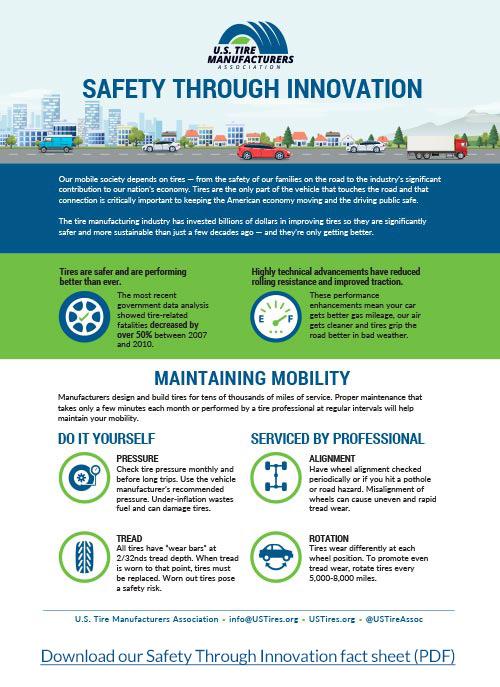National Tire Safety Week Spotlights Contributions of Innovation
May 29, 2017
Continual engineering improvements, combined with routine care, optimize safety
Along with the unofficial start of the summer travel season, this Memorial Day weekend marks the beginning of National Tire Safety Week. As millions of motorists take to the road, they will do so on tires that are more advanced than they were just a few decades ago.
Tires are the only part of the vehicle that touches the road. Their performance is critical to the strength of our mobile society and the safety of everyone in it. That’s why U.S. tire manufacturers have invested billions of dollars pursuing innovative ways to design and engineer tires that are safer than ever.
The investment is paying off: The most recent government data analysis showed tire-related crashes decreased by more than 50 percent between 2007 and 2010. Highly technical advancements in recent years have reduced rolling resistance while advanced tread technology has improved stability and traction in wet road conditions. In addition, run-flat tires keep working for an additional 50 miles after a puncture.
“As an industry, we’re proud of what we’ve achieved for our customers, and we’re excited for what the future brings,” said Anne Forristall Luke, president and CEO, U.S. Tire Manufacturers Association (USTMA), the industry’s national trade association. “Thousands of scientists and engineers are hard at work right now on tomorrow's tires, focusing on driving road safety forward.”
During National Tire Safety Week, USTMA and its members also remind motorists how they can help to keep their tires performing at peak safety levels, including simple, basic care they perform themselves as well as scheduling routine professional services.
Among the easiest do-it-yourself steps: checking the tire pressure monthly, including the spare, based on the vehicle manufacturer’s pressure settings. Drivers should also check the tire tread regularly. All tires have “wear bars” that are visible once tread has worn to a 2/32nds tread depth. At this point, tires pose a safety risk and must be replaced. Recommended professional maintenance includes tire rotations every 5,000 to 8,000 miles and wheel alignments, especially after striking a pothole, to prevent uneven or rapid tread wear.
“Proper tire care doesn’t require much time or effort,” says Luke. “And it goes a long way toward ensuring tires realize their true safety potential.”
National Tire Safety Week is supported by USTMA members: Bridgestone Americas, Inc.; Continental Tire the Americas, LLC; Cooper Tire & Rubber Company; The Goodyear Tire & Rubber Company; Kumho Tire U.S.A., Inc.; Michelin North America, Inc.; Pirelli Tire North America; Sumitomo Rubber Industries.; Toyo Tire Holdings of Americas Inc. and Yokohama Tire Corporation.
Download our Safety Through Innovation Fact sheet (PDF)

